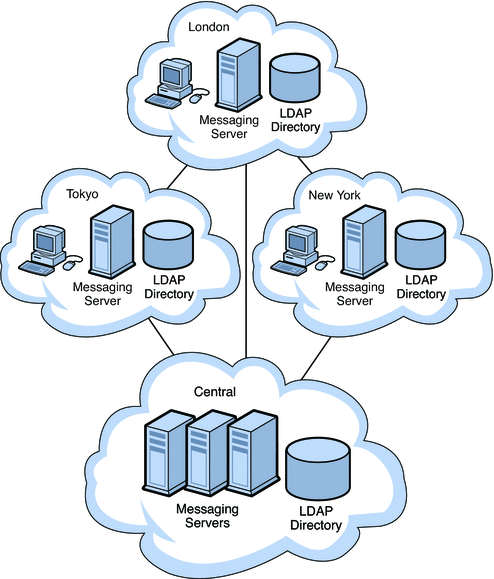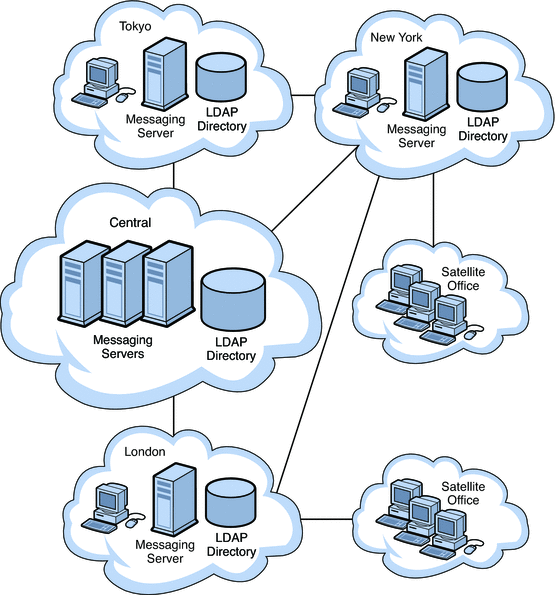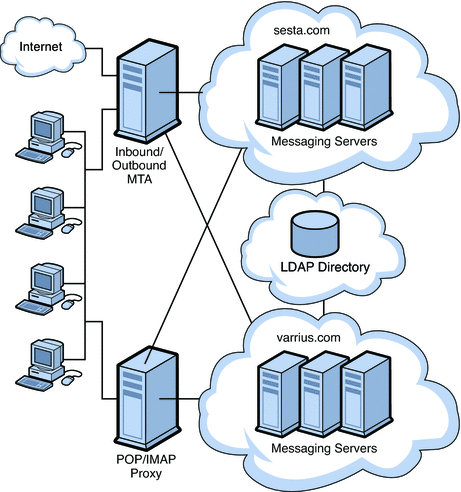Designing a Messaging Topology
Before you develop your topology, you need a strategy to determine where you are going to put your messaging servers in your organization. Depending on your goals, there are four common topologies that you can apply to your organization:
-
Consolidates most or all major system components and messaging servers at a single location.
-
Spreads most or all system components and messaging servers across multiple sites.
-
Consolidates some system components and distributes other components across multiple locations.
-
Hosts multiple domains and handles larger customer base. Like a central topology, it consolidates most system components at a single location.
Central Topology
In a central topology, most or all major system components and messaging processes are located at one site. Clients at remote sites communicate over a Wide Area Network (WAN) to the centralized messaging servers. Figure 12–1 shows a central topology.
Figure 12–1 Central Topology

You should consider a central topology for your organization when:
-
Messaging at remote sites is not mission critical.
-
Users tend to send and receive small text messages.
-
Your organization is located in one physical location or distributed across many small user populations.
-
You do not have remote support personnel.
-
Good bandwidth exists between remote sites and the central site (at least ISDN or better).
There are advantages to implementing a central topology. In general, a central topology has lower hardware and support costs. Central topologies tend to be easier to manage because you have a simplified messaging architecture and a directory replication structure with fewer replication agreements. With a simplified architecture and no need to coordinate installation among geographically distant sites, a central topology is faster to deploy.
That said, there are an equal number of disadvantages to implementing a central topology. A centralized approach heavily relies on a WAN. If the network does not function properly, users at the same site as well as users in remote locations could not send email to one another. Depending on network bandwidth and traffic, services might be slower during peak usage times. For users who send messages within the same domain, a central topology is inefficient. For example, looking at Figure 12–1, a message sent from one user in the Tokyo site would first travel to the Central site before being sent to another user in the Tokyo site.
Distributed Topology
In a distributed topology, most or all system components and messaging processes are distributed across multiple sites, usually at each remote site. Figure 12–2 shows a distributed topology.
Figure 12–2 Distributed Topology

You should consider a distributed topology for your site when:
-
Messaging at remote sites is mission critical.
-
Users send and receive large messages.
-
You have large user populations at remote sites.
-
Support personnel exists at remote sites.
-
There is poor bandwidth to remote sites.
If bandwidth significantly impacts your topology strategy, you should consider upgrading the bandwidth. In general, bandwidth is relatively inexpensive. You might also consider a Virtual Private Networking (VPN), which uses existing high bandwidth Internet pipes rather than dedicated lines behind a firewall.
There are advantages to implementing a distributed topology. Users at regional sites have faster access to their messages because they do not have to retrieve messages over the WAN. Furthermore, messages sent within a regional location will incur less messaging traffic than in a central topology. However, satellite offices still rely on the WAN. Therefore, if lots of message traffic is generated in a satellite office, the WAN might need to be upgraded.
The disadvantages of implementing a distributed topology are that typically you will have higher hardware costs and higher support costs as you maintain more hardware at more locations. Support costs are also higher because of the complexity of the distributed topology. For example, failover in a distributed topology is more difficult to implement than in a central topology. In addition, it is much slower to initially deploy Messaging Server because there are multiple servers spread across multiple sites.
Because Messaging Server accesses the LDAP directory, the LDAP server is a critical link in the mail delivery process. If you don’t use remote LDAP replicas, and the central LDAP is down, the messaging service will not be usable.
Hybrid Topology
In a hybrid topology, central and distributed topologies are combined to meet the needs of an organization. Figure 12–3 shows a hybrid topology.
Figure 12–3 Hybrid Topology

Organizations that benefit from a hybrid topology include those with many sites that have the ability to support a large user base. These sites that support them can house their own messaging servers. Some of these larger sites might have smaller satellite offices located in the general vicinity. But these satellite offices would not require their own messaging servers. Instead, the nearest major office would act as the central location for their services.
Service Provider Topology
In essence, a service provider topology is a large-scale central topology. Typically, a service provider hosts multiple domains and has a larger customer base than an enterprise. Systems are centralized and are able to support multiple users during peak hours. Figure 12–4 shows a service provider topology.
Figure 12–4 Service Provider Topology

- © 2010, Oracle Corporation and/or its affiliates
